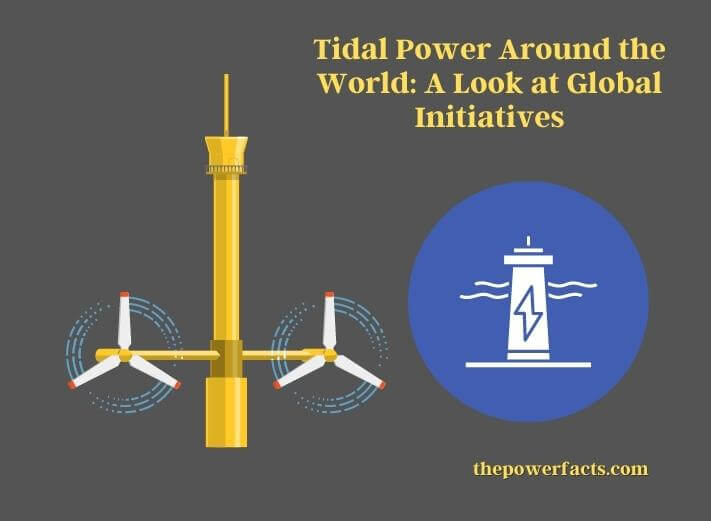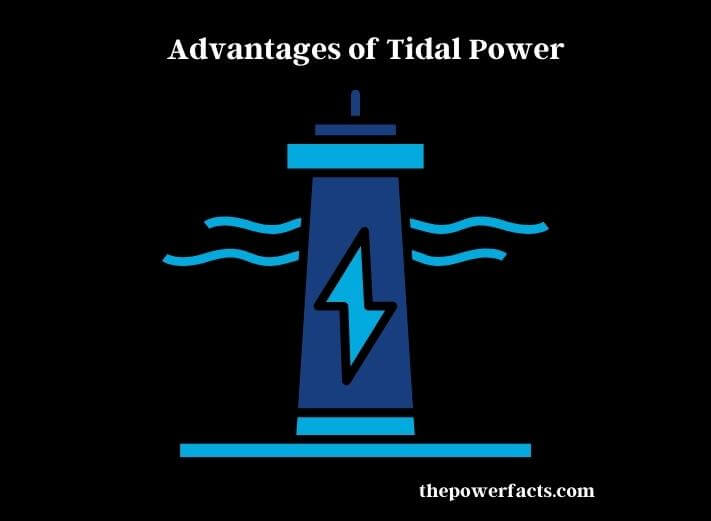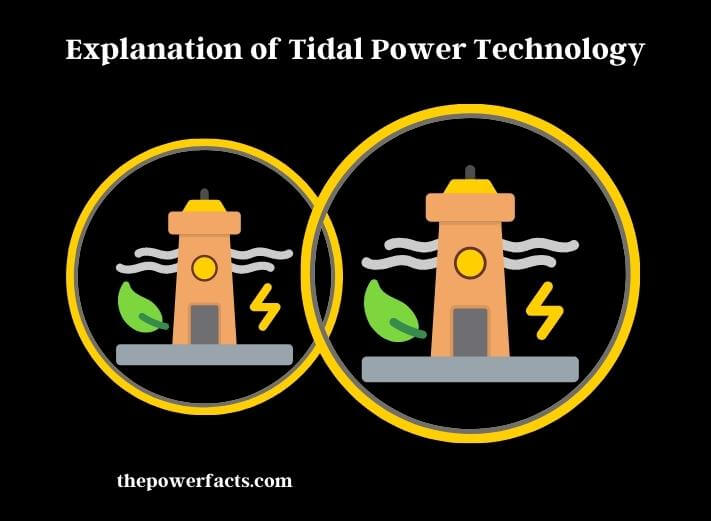The demand for energy continues to increase as the world’s population grows and economies expand. At the same time, there is growing concerned about the impact of fossil fuels on the environment, and the need for clean and renewable sources of energy has never been greater. One of the most promising options is tidal power, which harnesses the power of the tides to generate electricity.

Tidal power has several advantages over other forms of renewable energy. Unlike solar and wind power, tidal power is a more predictable and reliable source of energy, as the tides are highly predictable and occur twice a day. Tidal power also produces no greenhouse gas emissions, making it an environmentally friendly option.
Several countries around the world have recognized the potential of tidal power and have invested in projects to harness this energy.
Advantages of Tidal Power
Predictable and Reliable
Tidal power is a more predictable and reliable source of energy compared to solar and wind power. Tides occur twice a day and can be accurately predicted years in advance, making tidal power a highly reliable source of energy.
Environmentally Friendly
Tidal power produces no greenhouse gas emissions, making it an environmentally friendly option. It also does not require the use of fossil fuels, which further reduces its environmental impact.
High Energy Density
The energy density of tidal power is much higher compared to other forms of renewable energy, such as solar and wind power. This means that tidal power plants can generate more electricity with less equipment and infrastructure.
Long Lifespan
Tidal power plants have a longer lifespan compared to other forms of renewable energy. The turbines used in tidal power plants are designed to last for decades, making them a long-term investment.
Versatile
Tidal power plants can be built in various locations, including estuaries, bays, and straits. This makes tidal power a versatile option for generating electricity in different regions around the world.
Job Creation
Tidal power projects can create jobs in areas such as construction, engineering, and maintenance. This can have a positive impact on local economies and communities.

Tidal power has several advantages that make it a promising option for clean and renewable energy. There are also challenges that need to be addressed in order to fully realize its potential.
Tidal Power Initiatives Around the World
Now let’s take a look at some of the global initiatives that are driving the adoption of tidal power.
United Kingdom
The United Kingdom is currently one of the leaders in tidal power development. The country’s first tidal power plant, the Rance Tidal Power Station, was built in 1966 in Brittany, France. Today, the UK is home to the world’s largest tidal energy project, the MeyGen project, located in the Pentland Firth in Scotland. The project has a total capacity of 398 MW and is expected to power up to 175,000 homes.
Canada
Canada is also making significant strides in tidal power development. In 2009, the country’s first tidal power project, the Annapolis Royal Tidal Power Plant, was completed in Nova Scotia. Today, there are several tidal power projects in development in Canada, including the Fundy Ocean Research Center for Energy (FORCE) in Nova Scotia and the Vancouver Island Tidal Energy Project in British Columbia.
China
China is another country that is investing heavily in tidal power. In 2015, the country launched its first commercial-scale tidal power plant in the city of Putuo. The plant has a capacity of 3.2 MW and is capable of generating enough electricity to power 10,000 homes. China has also announced plans to build a 1 GW tidal power plant in the Shandong Province.
France
France is home to one of the world’s oldest tidal power plants, the Rance Tidal Power Station, which was built in 1966. Today, the country is working on several new tidal power projects, including the Normandie Hydro project, which has a capacity of 1 MW, and the Paimpol-Bréhat project, which has a capacity of 2 MW.
Australia
Australia is also exploring the potential of tidal power. In 2020, the country’s first grid-connected tidal power generator was deployed off the coast of Tasmania. The generator has a capacity of 100 kW and is capable of powering around 80 homes.
Challenges Facing Tidal Power
- High Initial Costs: The initial costs of building tidal power plants are high, which can make it challenging to attract investment. The cost of building infrastructure in harsh marine environments can also be expensive.
- Limited Sites: Tidal power plants can only be built in locations with significant tidal ranges, which limits the number of suitable sites for development.
- Environmental Impact: While tidal power is generally considered to be a clean and renewable source of energy, it can still have an impact on the marine environment. The installation of turbines can disrupt marine ecosystems, and the construction of infrastructure can affect local habitats.
- Maintenance Challenges: Tidal power plants require regular maintenance and inspection, which can be challenging in harsh marine environments.
- Technical Challenges: The development of tidal power technology is still in its early stages, and there are technical challenges that need to be addressed. For example, the design of turbines needs to be optimized for efficiency and durability.
- Intermittency: Tidal power is an intermittent source of energy, as tides only occur twice a day. This means that additional energy storage solutions may be needed to ensure a constant and reliable supply of electricity.
While there are several challenges facing tidal power, many of these can be addressed through continued research and development. As technology advances and the industry matures, tidal power has the potential to become an important source of clean and renewable energy around the world.
Explanation of Tidal Power Technology
Tidal power technology involves the use of turbines to harness the kinetic energy of tidal currents and convert it into electricity. The most common type of tidal power plant is the barrage or dam, which is constructed across an estuary or bay. As the tide comes in and the water level rises, water is trapped behind the barrage. When the tide recedes and the water level drops, the water is released through turbines, which spin and generate electricity.

Tidal turbines can be either a vertical or horizontal axis, and they work similarly to wind turbines. The turbines are placed in the path of the tidal currents and are designed to spin as the water flows past them. The spinning motion is then converted into electricity using a generator.
Tidal power technology has been around for decades, and several projects have been successfully implemented around the world. However, there are still technical challenges that need to be addressed in order to optimize the efficiency and durability of turbines and reduce their impact on the marine environment.
Tidal barrages and turbines, there are also other forms of tidal power technology being developed. One example is tidal kites, which are underwater devices that are tethered to the seabed and move in a figure-eight motion as they are pulled by the tidal currents. This motion is then converted into electricity using a generator.
Tidal power technology has the potential to be a significant source of clean and renewable energy around the world. As research and development continue, it is likely that new and innovative tidal power technologies will emerge, further expanding the potential of this promising source of energy.
Future Outlook
The future outlook for tidal power is promising, with increasing interest and investment in this technology around the world. As the world moves towards a more sustainable energy future, tidal power has the potential to play an important role in meeting global energy needs.
One of the key factors driving interest in tidal power is its potential to provide a stable and predictable source of renewable energy. Tidal power can help to reduce dependence on fossil fuels, which are finite and contribute to climate change. Tidal power has the potential to create jobs and boost local economies in coastal regions where tidal power projects are implemented.
As tidal power technology continues to develop and improve, it is likely that we will see an increasing number of tidal power projects being implemented around the world. While there are still challenges to be addressed, such as the environmental impact of tidal power projects and the cost of implementation, there is growing optimism that these challenges can be overcome.
In the coming years, it is likely that we will see continued investment in tidal power technology, as well as increased collaboration between governments, industry, and academic institutions to support the development of this promising source of clean and renewable energy. With continued innovation and investment, tidal power has the potential to become a major contributor to the global energy mix, helping to power the world while protecting the environment.
If you want to know can electrical energy change to sound energy. Here’s the explanation of your answer.
Wrap Up
Tidal power is a promising source of clean and renewable energy that has the potential to play a significant role in the global transition to sustainable energy. While there are still challenges facing the development of tidal power technology, significant progress has been made in recent years, and several successful projects have been implemented around the world.
One of the key advantages of tidal power is its predictability and reliability, as the tides occur twice a day and can be accurately forecasted. Additionally, tidal power does not produce greenhouse gas emissions, making it a clean and sustainable source of energy.
Challenges such as high initial costs, limited suitable sites, environmental impacts, and technical challenges must be addressed in order to fully realize the potential of tidal power. Continued research and development are needed to optimize the efficiency and durability of tidal power technology, and to reduce its impact on the marine environment.
Tidal power represents an important opportunity for the global transition to sustainable energy, and it is likely to play an increasingly important role in the years to come. With continued investment and innovation, tidal power can help to power the world while minimizing its impact on the environment.